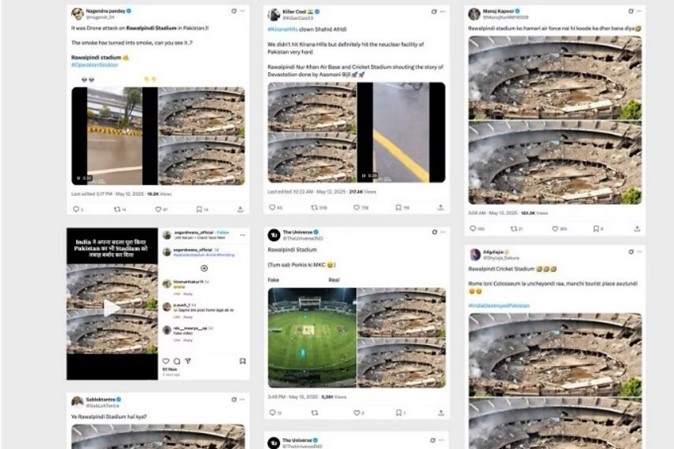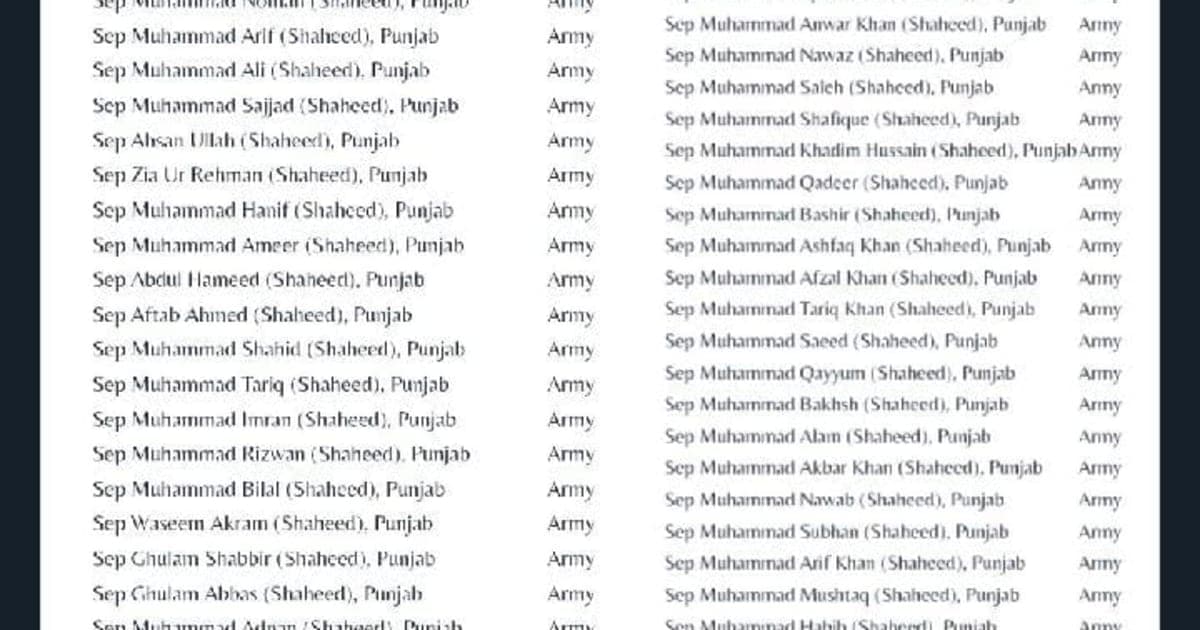Executive Summary
Following the Pahalgam terror attack, which occurred on 22nd April 2025, that claimed the lives of 26 civilians and left many wounded, the relations between Pakistan and India rapidly deteriorated into an unprecedented four-day crisis (7-10 May 2025). The media and social media networks on both sides have established a battlefield of misinformation and disinformation, claimed military victories, and downplayed enemy aggression. The verified analyses document a feedback loop in which unverified social media posts were sensationalized in mainstream media, resulting in false narratives and a challenge to credibility. For instance, Indian media aired the recycled footage of Gaza and Lebanon bombings and cited attacks on Pakistani cities. Interestingly, the fact-checkers were unable to verify the information due to the rapid flow of misinformation and disinformation. According to an analysis, out of 430 disinformation posts on X (formerly Twitter), 179 posts came from verified accounts, and only 17% of the total posts were labeled by community fact-checkers. It reflects the spread of misinformation and disinformation on social media.
This paper aims to examine the role of misinformation and disinformation in escalating tensions between two countries following the post-Pahalgam incident, by analyzing media reports, research, real-life examples, and findings from NGOs. It examines the role of state actors and non-state actors in weaponizing narratives and contributing to the fog of misinformation and disinformation. According to a report, nationalist influencers urged their followers to spread fake news on social media, and traditional press aired unverified content, which created the massive crisis of public mistrust. The instances of fake news ranged from the coup in Pakistan to the attack on Islamabad, and the destruction of Karachi Port by the Indian INS Vikrant. The concerning part in the entire episode was the celebrations of the Indian anchors in the studios on the fake news reporting and misleading the public.
Misinformation and Disinformation During the May 2025 Crisis
Following the unfortunate terror attack in Pahalgam, the Indian government blamed Pakistan for supporting the militants without conducting an inquiry or providing evidence. Pakistan angrily denied those allegations, cited them as baseless, and offered its assistance in an impartial investigation conducted by international investigators. The tension escalated when India, under Operation Sandoor, attacked Pakistan's territory on May 7, claiming to destroy militants' training camps. Following the Indian strikes, Pakistan also retaliated with surface-to-surface missiles and drone attacks on India, and claimed to have downed five fighter jets. The fire exchange remained active between the two countries until May 10, when the US president announced a ceasefire. The ceasefire averted an all-out war, and both countries claimed victory in the crisis.
During the crisis, the competing narratives based on fake news continued to escalate the situation. The domestic media in both countries shaped the news in a nationalistic context. The Indian media cited government sources and aired repeated claims of Pakistani aggression or destruction, whereas the Pakistani media kept questioning India’s actions and labelling them a blatant lie. Furthermore, the gap that emerged from the official briefings was filled by this misinformation and disinformation content spread through social media and WhatsApp forwards. These conflicting narratives, along with blackouts, led to confusion, panic, fear, and anger among the public. This scenario reflects the fact that, alongside a shooting war, a parallel information warfare was also underway between the two countries.
Analysis of the Findings
The findings of this paper reveal a wide range of false narratives disseminated during the crisis, as well as a mutual pattern of exploitation of media and social media platforms.
· Social Media Fabrication
Social media remained a primary platform to spread fairy tales during the crisis. For instance, a fake video was circulating on social media that showed DGISPR Ahmed Sharif Chaudhry allegedly admitting the loss of two fighter jets. In reality, the video was edited and integrated with an AI voice. Likewise, a fake image of the Pindi stadium was propagated, claiming the destruction, as shown in the picture below.

· Traditional Media Sensationalism
The mainstream media outlets in India engaged in sensational reporting without verifying the credibility of the news and sources. Most of the news was retrieved from social media platforms. For instance, on May 9, India Today’s anchor Sweta Singh declared, “Karachi is seeing its worst nightmare after 1971…it finishes Pakistan.” Within the hours, Karachi Port Trust posted on X that no attack had occurred and nullified the anchor’s claims. Similarly, Pakistani media and social media disseminated an AI-generated image of the UK-based newspaper The Daily Telegraph, praising the Pakistan Air Force as the "King of the Skies." Later, it was revealed that no such piece was ever published. These efforts aimed to exaggerate the image of one country's dominance over another, leading to public elation and panic.
· Official Propaganda and Counter-Claims
The official and media advanced their respective versions of the story, countering each other's claims. For instance, Pakistan’s Minister of Information and Broadcasting tweeted that those Indian soldiers had brought a white flag in their hands on the LoC, which appeared to be without evidence.
· Social Media Campaigns and Hate Speech
Besides the false narratives, the more pervasive development was the online propagation of hyper-nationalism and hate content. As noted by foreign analysts, the extreme-right Indian social media urged users to spread negative news against Pakistan, regardless of the truth. According to a report, during the dozens of rallies, Hindu nationalists chanted war slogans against Muslims and Kashmiris. This trend further led to the polarization of Indian society.
The table below summarizes some representative misinformation cases and their origins during the recent crisis between India and Pakistan.
|
Misinformation Claim |
Perpetrator/Platform |
Reality / Status |
Notes/Impact |
|
“Karachi port destroyed by Indian Navy (INS Vikrant)” |
Indian TV anchors and social-media users |
False – Karachi Port Authority reported no attack |
Sparked nationwide panic; Pakistan notified the UN. |
|
“Pakistan’s Army chief Gen. Munir arrested in coup” |
Indian TV & X |
False – Gen. Asim Munir was not detained |
Spread rapidly via WhatsApp; later debunked. |
|
“Indian forces entered Pakistan’s capital (Islamabad)” |
Multiple Indian news channels |
False – no evidence; Islamabad remained under govt control. |
Exacerbated Indian domestic euphoria. |
|
“Indian jets shot down in Pakistani airspace” |
Pakistani officials and media |
Dubious – Pakistan claimed 5 jets; India said 3 crashed (unknown origin) |
Truth unclear; part of mutual claims. |
|
“ISIS / TRF communications hacked by India” |
Pakistani-linked social accounts |
False – no evidence; likely narrative to blame India. |
Aimed to explain attack without admitting Pakistani link. |
|
“White flag raised by Indian soldiers (surrender)” |
Pakistani officials (Minister Tarar) |
Unverified – no confirmation or video; probably a false rumor. |
Attempt to claim symbolic victory. |
Table 1 Source: Center for the Study of Organized Hate
In short, the findings reveal an intense environment of information warfare, where dozens of high-profile claims are either fabricated or exaggerated on both sides. Fact-checking agencies issued the corrections, but the flow of fake content was so rapid that they could not fully verify every news.
Policy Options and Recommendations
Based on the above analysis, this paper suggests some policy options to mitigate the narrative-driven escalation between India and Pakistan.
· Strengthen Fact-Checking and Accountability
The independent fact-checking organizations should be encouraged and incentivized in both countries. Governments should officially recognize a network of cross-border fact-checkers, such as the India-Pakistan Truth Commission, to curb fake news jointly. Media regulators should adopt zero-tolerance policies regarding fake news reporting. Lastly, training workshops should be conducted to train journalists on war reporting ethics.
· Enhance Real-Time Official Communication
Both governments should commit to scheduled, transparent, and timely updates during the crisis. They may seek international support in a verification mechanism to check the information.
· Social Media Regulations
Social media is a significant source of spreading misinformation and disinformation. Hence, governments should legislate to regulate social media and prevent public mistrust, fear, and anger.
· Media Guidelines for Emergency Reporting
The relevant authorities in both countries should issue guidelines on war coverage during the crisis. For example, they may order to ban the sensationalist graphics, sirens, and unverified updates during security situations.
· Promote Cross-Border Dialogue on Information Integrity
Building trust is crucial. This paper recommends reinstating the UN-mandated Composite Dialogue Process to include an Information Confidence-Building Measure. This could establish a mechanism for emergency consultations: if either side detects a viral claim, it can request verification from the other through established hotlines. The acknowledgement or denial should be exchanged promptly.
Conclusion
The Indo-Pak crisis that followed the Pahalgam bombing demonstrated how quickly conflict dynamics can be shaped by misinformation and deception. A deadly terrorist act was followed in just two weeks by increasing military strikes and a conflicting narrative driven by aggressive rhetoric, manipulated films, and unconfirmed media reports. Officials and media from both Pakistan and India contributed to this information fog, exacerbating the public's anger and increasing the risk of mistakes. However, even amid the disorder, valuable lessons were learned. The public's opposition to misleading assertions, media advisories, and fact-checkers shows that there is still a need for reliable information. The crisis exposed serious flaws in how society and governments manage digital content during times of crisis. Information integrity must be a top national security priority for both India and Pakistan to prevent such crises in the future. Developing cross-border verification systems, imposing media accountability, bolstering real-time communication, and involving digital platforms and civil society are all necessary to achieve the objectives. Anchoring perception in truth is essential in an era when perception often precedes reality. The suggested actions, if taken in good faith, have the potential to stabilize the current unstable information environment, lowering the possibility of escalation and creating room for negotiation rather than conflict.




